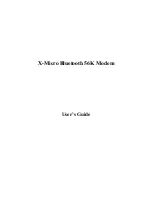
56
MT2834BLR Owner’s Manual
5.6
Synchronous Mode Testing
The following tests must be run with your modem in Synchronous mode (DIP Switch #12 in the
Up (OPEN) position), DIP Switch #9 controls the modem’s Synchronous mode testing function.
(Refer to
Chapter 9
for DIP Switch information.) The test procedures for Synchronous mode are
different from those for Asynchronous mode. In Synchronous mode, you cannot access the
modem’s AT commands.
With DIP Switch #9, you can perform either the Digital Loopback Test (remote/automatic) or the
Digital Loopback Test (local/manual) in Synchronous mode, as described in the following
sections. There is also a Local Analog Loopback Test, documented in section 5.6.
5.7
Local Analog Loopback Test (Synchronous Mode)
This test diagnoses the connection between your modem and your computer or terminal. In Local
Analog Loopback Test mode, data entered at the local computer or terminal are sent through the
local modem’s transmit and receive circuits (much like entering an ATU or ATU1 command in
Asynchronous mode). You then compare the test characters (multiple upper case “U” characters
in Figure 8-5) on your monitor with the characters you typed. If the characters don’t match, check
your computer’s COM port setting, then verify your communication software’s configuration.
To initiate the Local Analog Loopback Test, with the modem in Synchronous mode:
1.
Enter AT&M1U. This first switches your modem form asynchronous to synchronous mode,
and places it into the Analog Loopback/Originate mode. The modem is now out of the
Command mode and in the pseudo On-Line mode.
2. Once you receive a connect message (if responses are enabled), enter data from your
keyboard. For this test, typing multiple upper case "U" characters is a good way to send an
alternating test pattern of ones and zeros.
3.
For a more complete test, you should also test the modem in Answer mode. To do this, Type
the Escape Sequence (+++AT<CR> or <BREAK>AT<CR>) which brings your modem into
Command mode, while still maintaining the connection. Then type AT&M1U1 and hit ENTER
to place the modem in Analog Loopback mode, in the Answer mode. Then repeat step 2.
Computer or Terminal
Local MultiModem
Digital
Analog
UUUUU
UUUUU
Figure 5-4. Synchronous Mode Local Analog Loopback Test
Summary of Contents for CC1600 Series
Page 1: ...CC1600 Series MT2834BLR Intelligent Data Fax Modem Owner s Manual...
Page 5: ...CC1600 Series Chapter 1 Introduction and Description...
Page 8: ...8 MT2834BLR Owner s Manual...
Page 9: ...CC1600 Series Chapter 2 Installation and Connection...
Page 18: ...18 MT2834BLR Owner s Manual...
Page 19: ...CC1600 Series Chapter 3 Communications Software and Modem Basics...
Page 31: ...CC1600 Series Chapter 4 Modem AT Commands...
Page 51: ...CC1600 Series Chapter 5 Modem Testing...
Page 59: ...CC1600 Series Chapter 6 Warranty Service and Tech Support...
Page 65: ...CC1600 Series Appendices...
Page 76: ...76 MultiModemBL Owner s Manual Z ZIP files 29...
















































